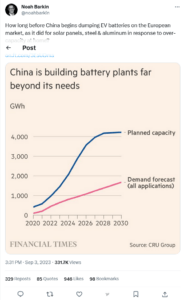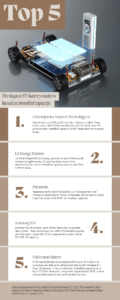China has long been known as the economy that will spend dubious billions on infrastructure, erect apartment buildings no one lives in, and subsidizes its domestic industries to put foreign competition out of business. China is the main source of any supply glut. They did it with steel and solar. And now Chinese companies may be doing it with electric vehicle batteries.
Production capacity at China’s battery factories is expected to reach 1,500 gigawatt-hours this year — enough for 22 million EVs. The 1,500 GWh of car batteries made in China is forecast at roughly two times the demand level of 636 GWh, according to data from CRU Group, a London-based business intelligence firm focused on commodity markets.
China’s overproduction will lead to a market glut that will, in theory, force competitors – almost all in Asia with the exception of Tesla – to lower prices. That sounds good if it makes EVs more affordable, but what is more likely to happen is that China’s oversupply in this market will put rivals out of business. It will surely make it next to impossible for a U.S. EV battery maker to enter this market.
China is set to own the EV battery space. Its only real competition is in Japan and South Korea.
Rhodium Group analyst Noah Barkin said publicly that it is only a matter of time before China is dumping the excess into Western EV markets.
 For years, China has taken its cues from Washington and Brussels on the new post-fossil fuels machines and technologies they’re clamoring for to reach their emissions goals.
For years, China has taken its cues from Washington and Brussels on the new post-fossil fuels machines and technologies they’re clamoring for to reach their emissions goals.
In Beijing, the attitude around the poker table is “we see your climate fears and raise you 100 to satisfy all your green tech needs.” For a country that the West has long known to be more concerned about full employment than Co2 levels, it should come as a no-brainer that provincial leaders in the country would see to it that each of them houses new EV battery supply chain manufacturers, destined for export.
In 2020, China had around 4.5 million EVs on the road. That was enough to make China the largest EV market. But China has around 270 million cars on the road. The idea is to get out ahead of Western automakers in this space, and compete directly with the Japanese and South Koreans automakers. As it is, Ford is partnering with China battery maker CATL to build out its EV fleet of cars and trucks.
Why CATL? (Which will receive Inflation Reduction Act tax benefits to set up shop in Michigan)
“The simple answer is that Chinese companies have managed to make good-quality batteries in large quantities and at a low cost. It will be commercially unviable to avoid using Chinese batteries, and it will take a long time for (American) domestic battery companies to rival the size and efficiency of CATL,” the MIT Technology Review published in an article by New York City reporter Zeyi Yang, a China EV cheerleader.
No one will ever be able to compete with China on price without massive subsidies. China gets those back home, though that depends on the company. Big players like CATL are also no slouches. They have planned for this for years, all with hopes of being a global player in the EV auto industry.
“China has a 10- to 15-year head start on the rest of the world when it comes to making EV batteries,” analyst Chris Berry from House Mountain Partners told Marketplace, a public radio show focused on global business stories.
China has invested in lithium and other battery minerals, he said — especially “the refining of the material. And then the cell and the pack production. The battery production as well.” China has the full supply chain in its sights, not unlike the solar industry, which China dominates in spades.
The increase in battery demand drives the demand for critical materials like lithium.
In 2022, lithium nickel manganese cobalt oxide (NMC) remained the dominant battery chemistry with a market share of 60%, followed by lithium iron phosphate (LFP) with a share of just under 30%, and nickel cobalt aluminum oxide (NCA) with a share of about 8%, according to a 2023 EV battery trends report by the International Energy Agency (IEA).
LFP cathode chemistries have reached their highest share in the past decade. This trend is driven mainly by the preferences of Chinese car makers. Around 95% of the LFP batteries for electric cars went into cars made in China.
BYD Auto represents 50% of LFP demand, with Tesla accounting for just 15%. Moreover, around 85% of the cars with LFP batteries manufactured by Tesla were manufactured in China for the China market primarily, with the rest manufactured in the United States with battery cells all imported from China, according to the IEA.
In total, only 3% of EVs with LFP batteries were made in the U.S. last year.
“China’s investment in EV batteries has paid off,” Scott Kennedy of the Center for Strategic and International Studies told Marketplace this summer.
At the start of 2022, China had 558 GWh of EV battery capacity ready to go. The U.S. had a measly 44 GWh, according to S&P Global Market Intelligence. Volkswagen says it will build six new factories in the EU over the next seven years for a combined 240 GWh, but China is likely to put a damper on those plans.
New laws here, namely the Inflation Reduction Act, provide tax benefits for companies that produce batteries in the U.S. But other than Tesla, the U.S. is far behind and is nowhere near a market leader in the production of the main power source behind a market Washington, and Brussels, insist on disrupting to lower greenhouse gas emissions. It appears the U.S. is not backing down from EVs. China is poised to be a big beneficiary of that growth story.
Goldman Sachs said that they think the U.S. and Europe could end their reliance on China for EV batteries by 2030.
“The U.S. is behind the curve in volume production of batteries for EVs and China’s overproduction threatens to undermine all non-China production,” said CPA chief economist Jeff Ferry. “The IRA tax credits are helpful but with Ford dependent on a Chinese battery-maker and GM on a Korean battery-maker, the prospect of a complete U.S. solution is limited to a few startups like Quantumscape. We must think today about putting in place policies to keep out cut-price Chinese products and spur U.S. innovation and product development.”
McKinsey & Company says that EV batteries will be the bulk of the new battery tech end-market, but stationary storage for homes and longer-life batteries for consumer electronics are also part of this market utilizing similar technology and resources.
In the meantime, the Financial Times thinks overcapacity will be a headwind for Western companies looking to move into the top five of global EV battery manufacturers. China is absolutely in the pole position here and the advent of EVs will one day launch Chinese automakers onto the world stage, a stage once dominated by Western car companies and then later by Japan and more recently, South Korea. China sees EVs as their turn to become a top player in the world’s all-important auto trade.














